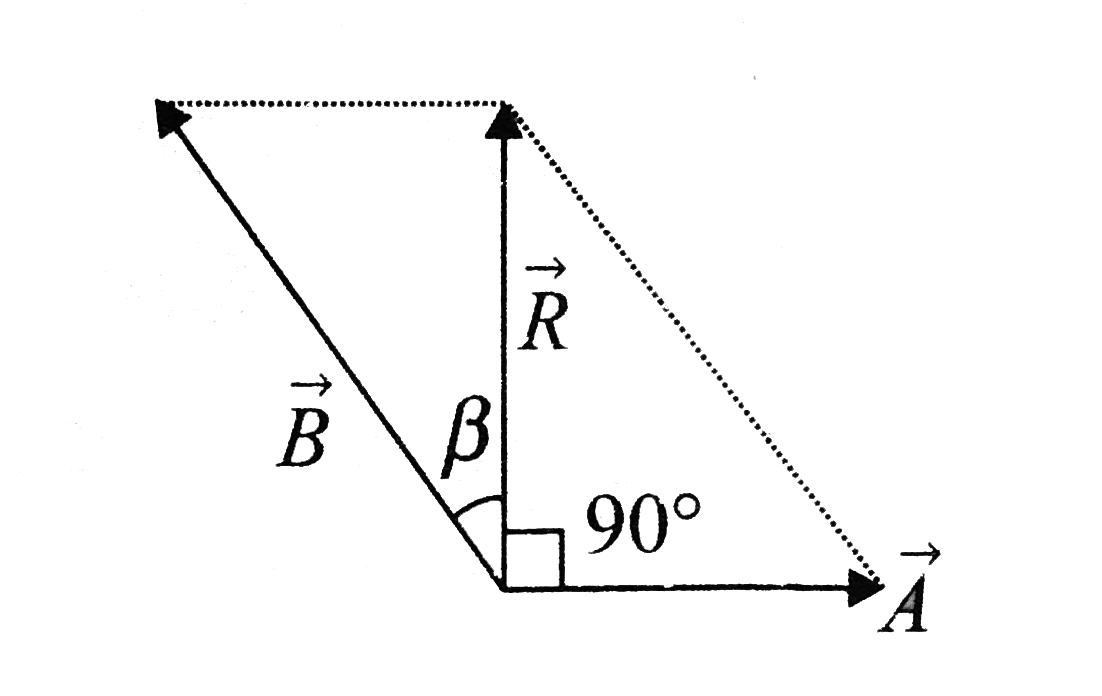The resultant of two vectors →Aand→B perpendicular to the vector →Aanditsmagnitudequal→halfofthemagnitudeofthe→−−→r vec B.F∈doutthe∠between vec A and vec B.
To find the angle between the vectors →A and →B, we can follow these steps:
Step 1: Understand the Problem
We know that the resultant of two vectors →A and →B is perpendicular to →A and its magnitude is equal to half the magnitude of →B.
Step 2: Set Up the Vectors
Assume:
- The vector →A is along the x-axis.
- The vector →B makes an angle θ with →A.
Step 3: Resolve Vector →B
The components of vector →B can be expressed as:
- Bx=Bcosθ (horizontal component)
- By=Bsinθ (vertical component)
Step 4: Resultant Vector
The resultant vector →R of →A and →B can be expressed as:
→R=→A+→B
Since →R is perpendicular to →A, we can say:
→R⋅→A=0
Step 5: Magnitude of the Resultant Vector
Given that the magnitude of the resultant vector R is equal to half the magnitude of →B:
|→R|=12|→B|
Step 6: Calculate the Magnitude of the Resultant
The magnitude of the resultant vector can be calculated using the Pythagorean theorem:
|→R|=√A2+B2y=√A2+(Bsinθ)2
Since |→R|=12|→B|, we can set up the equation:
√A2+(Bsinθ)2=12B
Step 7: Substitute and Simplify
Squaring both sides gives:
A2+(Bsinθ)2=14B2
Rearranging gives:
A2=14B2−(Bsinθ)2
Step 8: Use the Perpendicular Condition
From the perpendicular condition, we have:
A=Bsinθ
Substituting this into the equation gives:
(Bsinθ)2=14B2−(Bsinθ)2
This simplifies to:
2(Bsinθ)2=14B2
Step 9: Solve for sinθ
Dividing both sides by B2:
2sin2θ=14
Thus:
sin2θ=18
Taking the square root gives:
sinθ=12√2orsinθ=√24
Step 10: Find the Angle
Using sinθ, we can find θ:
θ=45∘
Step 11: Calculate the Angle Between →A and →B
Since the resultant is perpendicular to →A, the angle between →A and →B is:
Angle=90∘+θ=90∘+45∘=135∘
Final Answer
The angle between →A and →B is 135∘.
---
We know that the resultant of two vectors →A and →B is perpendicular to →A and its magnitude is equal to half the magnitude of →B.
Assume:
- The vector →A is along the x-axis.
- The vector →B makes an angle θ with →A.
The components of vector →B can be expressed as:
- Bx=Bcosθ (horizontal component)
- By=Bsinθ (vertical component)
The resultant vector →R of →A and →B can be expressed as:
→R=→A+→B
Since →R is perpendicular to →A, we can say:
→R⋅→A=0
Given that the magnitude of the resultant vector R is equal to half the magnitude of →B:
|→R|=12|→B|
The magnitude of the resultant vector can be calculated using the Pythagorean theorem:
|→R|=√A2+B2y=√A2+(Bsinθ)2
Since |→R|=12|→B|, we can set up the equation:
√A2+(Bsinθ)2=12B
Squaring both sides gives:
A2+(Bsinθ)2=14B2
Rearranging gives:
A2=14B2−(Bsinθ)2
From the perpendicular condition, we have:
A=Bsinθ
Substituting this into the equation gives:
(Bsinθ)2=14B2−(Bsinθ)2
This simplifies to:
2(Bsinθ)2=14B2
Dividing both sides by B2:
2sin2θ=14
Thus:
sin2θ=18
Taking the square root gives:
sinθ=12√2orsinθ=√24
Using sinθ, we can find θ:
θ=45∘
Since the resultant is perpendicular to →A, the angle between →A and →B is:
Angle=90∘+θ=90∘+45∘=135∘
The angle between →A and →B is 135∘.
Topper's Solved these Questions
- BOOK - PRADEEPCHAPTER - KINEMATICSEXERCISE - 4 Short answer30videos
KINEMATICS
- BOOK - PRADEEPCHAPTER - KINEMATICSEXERCISE - 5 Short answer6videos
KINEMATICS
- BOOK - PRADEEPCHAPTER - KINEMATICSEXERCISE - 2 Short answer26videos
KINEMATICS
- BOOK - PRADEEPCHAPTER - GRAVIATIONEXERCISE - Assertion-Reason Type Questions19videos
GRAVIATION
- BOOK - PRADEEPCHAPTER - LAWS OF MOTIONEXERCISE - Assertion- Reason Type Questions17videos
LAWS OF MOTION
Similar Questions
Three vectors →A,→B and →C are related as →A+→B=→C .If vector →C is perpendicular to vector →A and the magnitude of →C is equal to the magnitude of →A, what will be the angle between vectors →A and →B.
View SolutionThe resultant of two velocity vectors →A and →B is perpendicular to →A. Magnitude of Resultant →R is equal to half magnitude of →B. If the angle between →A and →B is (30θ)∘, then value of θ is ?
View Solution
Knowledge Check
- Question 1 - Select One
The resultant of two vectors →Aand→B is perpendicular to the vector →A and its magnitude is equal to half the magnitude of vector →B. What is the angle between →Aand→B ?
A30∘B45∘C150∘D120∘ - Question 2 - Select One
The resultant of two vectors →A and →B is perpendicular to the vector →A and its magnitudes is equal to half of the magnitudes of vector →B (figure). The angle between →A and →B is
 A120∘B150∘C135∘DNone of these
A120∘B150∘C135∘DNone of these - Question 3 - Select One
Two vectors →A and →B have equal magnitudes. If magnitude of →A−→B is equal to (n) times the magnitude of →A−→B, then angle between →A and →B is ?
Acos−1(n−1n−1)Bcos−1(n2−1n2+1)Ccos−1(n−1n−1)Dcos−1(n2−1n2+1)
Two vectors →Aand→B have equal magnitudes.If magnitude of (→A+→B) is equal to n times of the magnitude of (→A−→B) then the angle between →Aand→B is :-
View SolutionIf →a and →b are unit vectors find the angle between →a+→b and →a−→b.
View SolutionIf vectors →A,→ Band→Chave magnitudes 5,12and13unitsand vec A + vec B =vec C,f∈dthe∠between vec B and vec C.
View SolutionIf a,b,c are three mutually perpendicular vector each of magnitude unity, then what is the magnitude of ∣∣→a+→b+→c∣∣?
View SolutionTwo vectors vec A and vec B have equal magnitudes.The magnitude of (vec A+vec B) is 'n' times the magnitude of (vec A-vec B).The angle between vec A and vec B is:
View Solution

